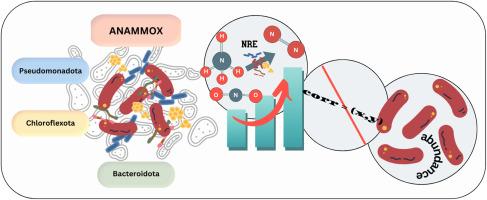关于 UASB/ EGSB 反应器中微生物 ANAMMOX 群的系统文献综述。
IF 8.1
2区 环境科学与生态学
Q1 ENVIRONMENTAL SCIENCES
引用次数: 0
摘要
厌氧氨氧化(ANAMMOX)是一个新兴的研究领域,因为它在效率和成本方面都优于以往的废水生物处理工艺。厌氧氨氧化细菌能够在厌氧条件下代谢 NH4+ 和 NO2- 产生 N2。尽管进行了大量研究,但对栖息在厌氧相关过程中的主要微生物的共存性和相互关系的研究还很缺乏。本系统性文献综述采用 PSALSAR 方法评估上游反应器中厌氧菌和功能微生物的元基因组数据。综述了有关厌氧细菌的生理学、代谢途径和抑制作用的基本信息,并确定了氨氧化细菌(AOB)、亚硝酸盐氧化细菌(NOB)、氨氧化古细菌(AOA)和反硝化细菌等功能细菌。在观察到的文献中,Kuenenia 菌属和 Brocadia 菌属是最常被测序的菌属。不管影响微生物群落的关键运行参数和配置如何,假单胞菌群、绿僵菌群和类杆菌群都很普遍。相互关系分析表明,一个门类代谢的多功能性与其在所观察到的污水处理文献中的存在之间存在正相关。钙富集菌门(Calditrichota)、粘球菌门(Myxococcota)和脱球菌门(Deinococcota)等几个菌门的代表性极低,这一发现应进行更详细的研究。没有证据表明高 Anammoxos 比率与高脱氮效率相关,因为一些研究发现,尽管 Anammoxos 丰度较低,但脱氮效率却很高 (本文章由计算机程序翻译,如有差异,请以英文原文为准。

A systematic literature review of microbial anammox consortia in UASB/ EGSB-reactors
Anaerobic ammonium oxidation (anammox) poses an emerging research field as it can outstand previous processes of biological wastewater treatment in terms of efficiency and costs. Anammox bacteria have the ability to metabolise NH4+ and NO2− to produce N2 under anaerobic conditions. Despite numerous studies, there is a lack of research on the co-occurrence and interrelationship of the predominant microbes that inhabit anammox-related processes. This systematic literature review follows the PSALSAR approach to assess metagenomic data on anammox bacteria and functional microbes in upstream reactors. Essential information on the physiology, metabolic pathways and inhibitory effects of anammox bacteria are reviewed and functional bacteria such as ammonia-oxidising bacteria (AOB), nitrite-oxidising bacteria (NOB), ammonia-oxidising Archaea (AOA) and denitrifying bacteria are identified.
Candidatus Kuenenia and Candidatus Brocadia were the most frequently sequenced genera in the observed literature. Pseudomonadota, Chloroflexota and Bacteroidota were prevalent regardless of crucial operational parameters and configurations that affect the microbial community. Interrelationship analysis revealed a positive association between the versatility of a phylum's metabolism and its presence in the observed wastewater treatment literature. Several groups, such as Calditrichota, Myxococcota and Deinococcota are highly underrepresented, a finding that should be investigated in more detail. No evidence was found to suggest that high anammox ratios are correlated with high nitrogen removal efficiencies, as some studies found high efficiency despite low anammox abundance (<1%).
求助全文
通过发布文献求助,成功后即可免费获取论文全文。
去求助
来源期刊

Chemosphere
环境科学-环境科学
CiteScore
15.80
自引率
8.00%
发文量
4975
审稿时长
3.4 months
期刊介绍:
Chemosphere, being an international multidisciplinary journal, is dedicated to publishing original communications and review articles on chemicals in the environment. The scope covers a wide range of topics, including the identification, quantification, behavior, fate, toxicology, treatment, and remediation of chemicals in the bio-, hydro-, litho-, and atmosphere, ensuring the broad dissemination of research in this field.
 求助内容:
求助内容: 应助结果提醒方式:
应助结果提醒方式:


